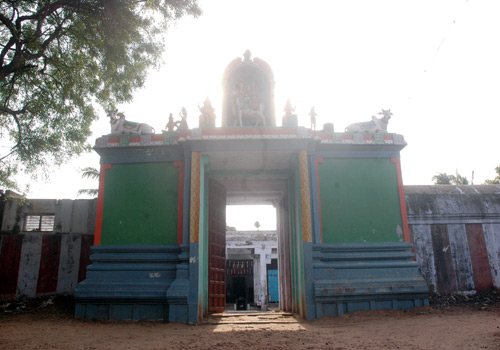Tirugnana Sambandar as a child devotee of Lord Shiva and blessed with a
high degree of poetic abilities by Mother Parvathi, fought the Jains who
waged a war against Saivism.
According to the literary history of
Tamilnadu, it was Child Sambandar and the ripe old Saivite saint, who
had a first hand knowledge and experience of the Jain designs fought the
war together. In the various challenges Sambandar was drawn, he
defeated the Jains and re-established the glory of Saivism in Tamilnadu
and almost eliminated Jainism from the Tamil soil.
As was agreed
between Sambandar and the Jains, the latter were hanged after Sambandar
won every challenge. However, Sambandar had to incur the sin of causing
the death of the Jains and wanted to go to Kasi to make amends for the
sin. He prayed for the permission of Lord Shiva in Sirkali to proceed
to Kasi.
Lord appeared before Sambandar and brought Ganga here itself.
The child saint had a dip in holy Ganga and got relieved of the sin. A
temple was erected here later.
Festival:
New Moon day in the month of Thai (January-February) and Full Moon day
in the month of Chithirai (April-May) are the festivals grandly
celebrated in the temple.
Opening time:
The temple is open from 6.00 a.m. to 10.30 a.m. and 5.00 p.m. to 7.30 p.m.
Velladainathar graces as a Banalinga on a square Peeta in the sanctum
sanctorum. River Ganga sprang in the well here on the New Moon day in
the Thai month (January-February).
Based on this story, the holy spring
is opened for the use of devotees on this day only and will be closed
during the rest of the year
Lord
Vinayaka in the temple is on a Lotus seat with an umbrella above Him
and two fans called Samaram. Lord Muruga, against the tradition of
facing East, is seen facing the South, a direction attributed to Guru.
Lord Muruga is revered as Jupiter-Dakshinamurthy in this temple. He
graces with His consorts Valli and Deivanai. Special pujas are
performed in His shrine on Thursdays, a day attributed to Guru. There
are shrines for Mother Durga with eight hands and Sattainathar. There
is no shrine for Navagrahas the 9 planets.
The procession idol of Gnanasambandar is brought to this
temple from the Sirkali Brahmmapureeswarar temple. The Presiding deity
of this temple (Velladainathar) and Goddess (Kavianganni) grants
audience to Sambandar and give him the Theertham. Sambandar returns to
Sirkali in the evening. This is celebrated as grand festival.
During
his pilgrimage, Saivite Saint Sundarar came to this place to worship
Shiva, but could not find the temple as the place was a dense jungle
then. He sadly continued his journey with his followers. When he felt
very hungry, an old man came to him and said that he was feeding Shiva
devotees at a nearby place and asked him to come there for a lunch.
Sundarar and his followers enjoyed a good feast coupled with hospitality
of the host. After the lunch, Sundarar slept for a while as he was
very tired then. When he woke up, he found neither the feeding camp nor
any sign of feeding event. He realized that it was Lord Shiva who
quenched his hunger.
Lord Shiva appeared before Sundarar and showed him
the temple.
This Feeding event is celebrated as a great festival on
the Full Moon Day of the month of Chithirai (April-May) in the temple.
Devotees believe that worshipping the Lord here would ensure them a life
free of hunger.
Moolavar:Velladainathar
Urchavar:Somaskandar
Amman / Thayar:Kavianganni
Do's:
- Do pray your Ishta Devata before pilgrimage to Temple.
- Do contact Temple Devasthanam information centre for enquiry, temple information and for Pooja details etc.
- Do reserve your travel and accommodation at Temple well in advance.
- Do bath and wear clean clothes before you enter the temple.
- Do concentrate on God and Goddess inside the temple.
- Do maintain silence and recite Om Namahsivaya or your Istamantram to yourself inside the temple.
- Do observe ancient custom and traditions while in Temple.
- Do respect religious sentiments at Temple.
- Do deposit your offerings in the hundi only.
Don't s:
- Do not come to Temple for any purpose other than worshipping of God and Goddess.
- Do not smoke at Temple.
- Do not consume alcoholic drinks at Temple.
- Do not eat non-vegetarian food in the Kshetram.
- Do not approach mediators for quick Darshanam. It may cause inconvenient to others.
- Do not carry any weapon inside the temple.
- Do not wear any head guards like helmets, caps, turbans and hats inside the temple premises.
- Do not perform Sastanga Pranama inside the Sanctum Sanctorum.
- Do not take much time while performing Sparsa Darshanam to God in Garbhagriha.
- Do not buy spurious prasadams from street vendors.
- Do not encourage beggars at Temple.
- Do not spit or create nuisance in the premises of the temple.
